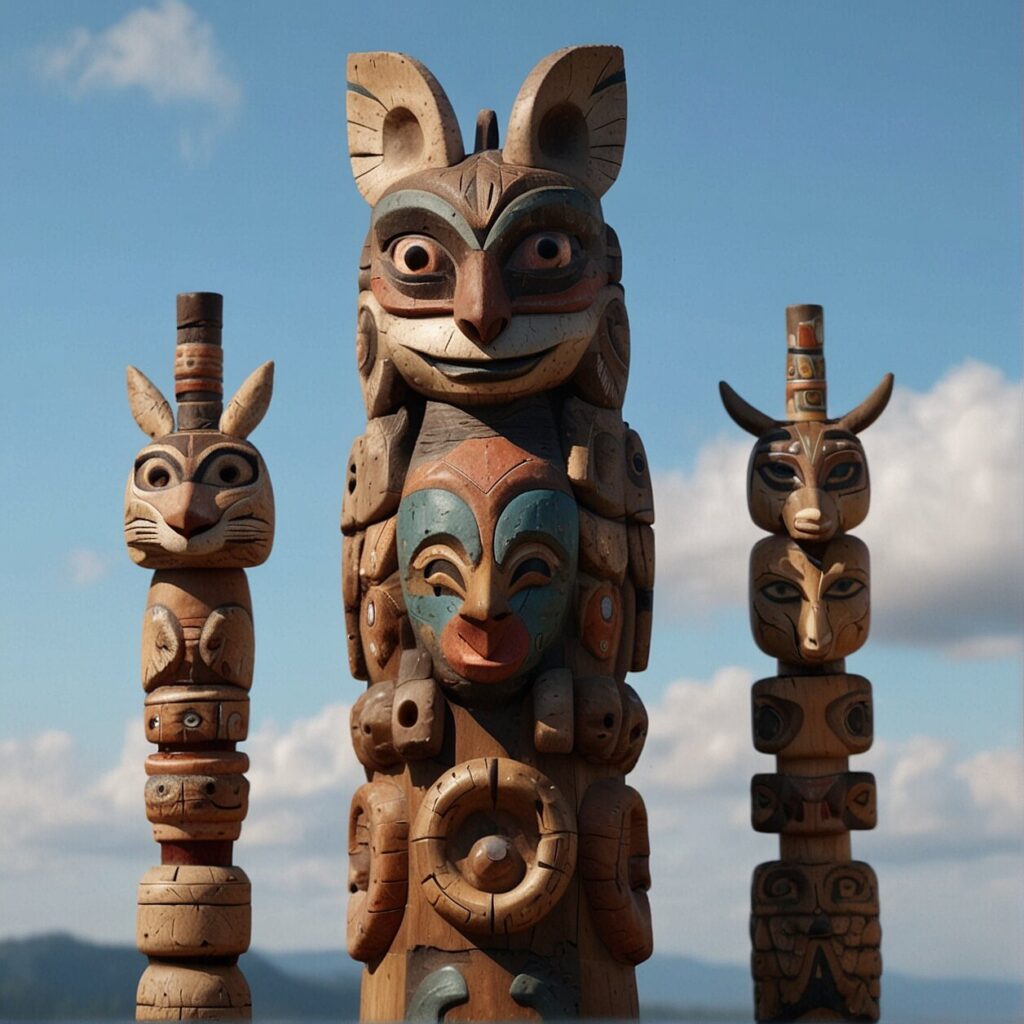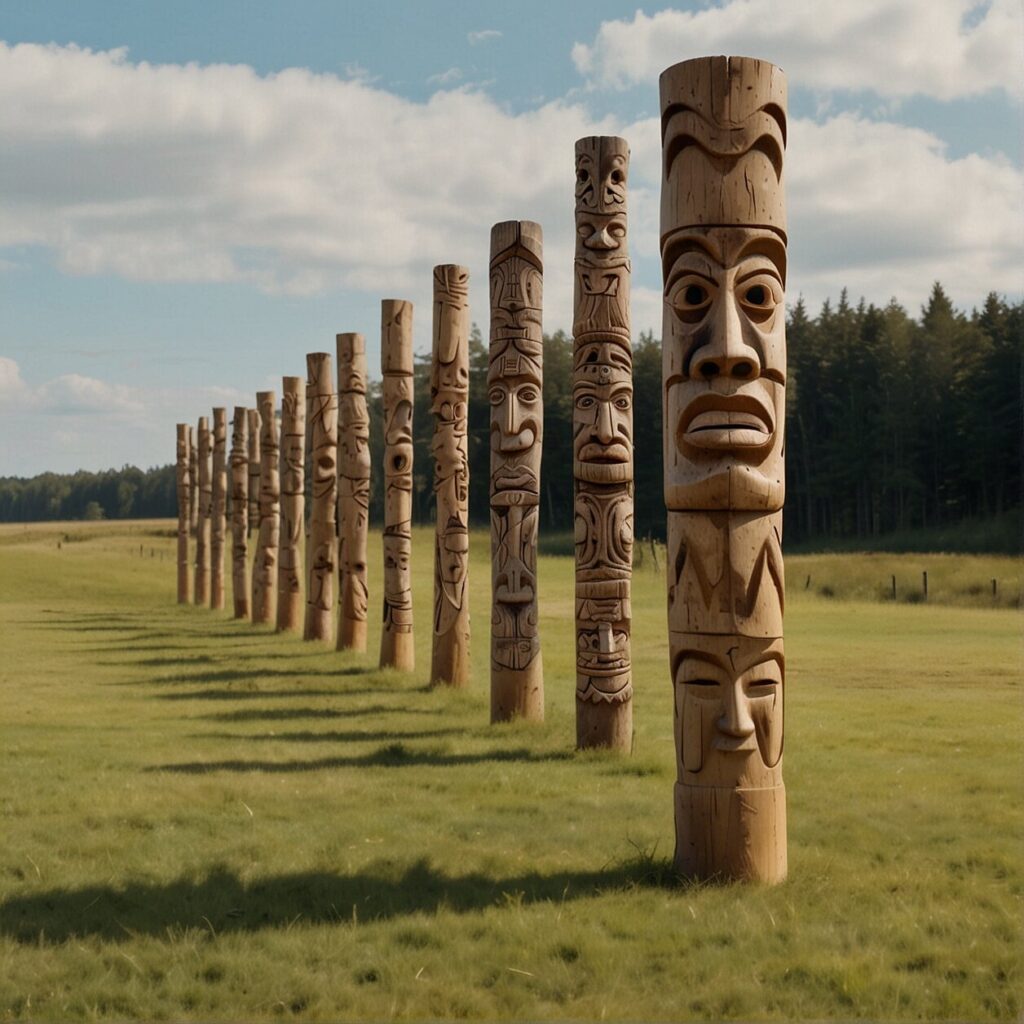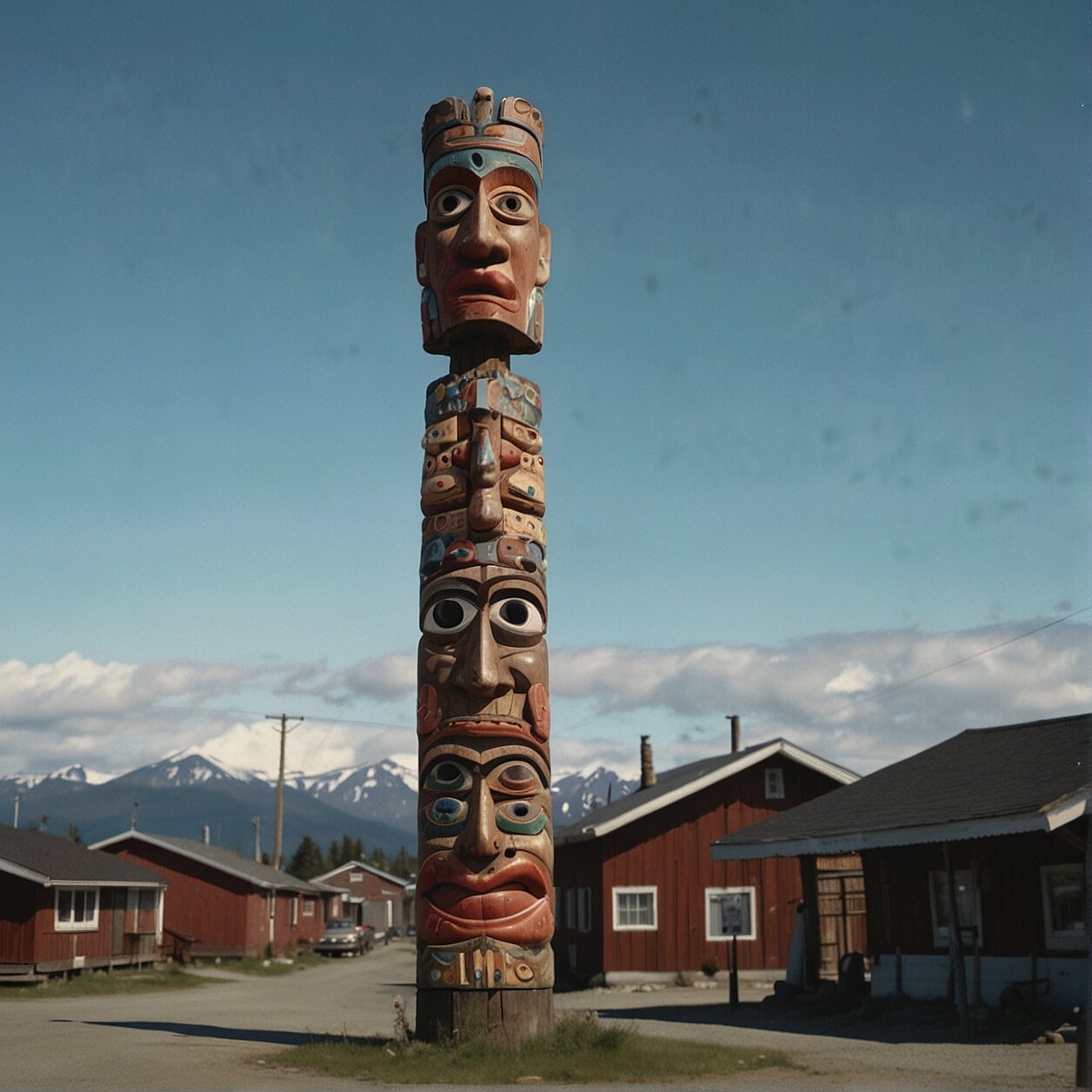Carving Stories: Totem Pole Craftsmanship in Alaska, USA
Imagine stepping into an ancient world where legends come to life, intricate art meets profound culture, and stories are told not in words, but through towering, multicolored totem poles. Welcome to Alaska – the heartland of the native communities that have held the harbingers of totem pole art for generations. These poles, a vibrant medley of skill, creativity, and profound cultural legacies offer us a mesmerizing gaze into the intangible heritage and enduring ingenuity of the Alaskan natives.
- Are you intrigued by the history of totem pole art that maps back to epochs untraced, breathing life into age-old narratives?
- Do you marvel at the profound cultural relevance that these monolithic structures hold within the heartbeat of the Alaskan native communities?
- Or do you stand in awe of the distinct craftsmanship, aesthetic genius, and symbolic mastery that define these towering monuments?
“Totem pole art is not just ‘art’. It is the silent song of culture, the prolific language of tradition, the imprint of an unspoken past, and the echo of a people’s identity.”
Embark with us on a rich and captivating exploration into all things totem pole art. Here, you’re not just witnessing art, you’re experiencing a culture.
Unraveling the Roots: The History of Totem Pole Art in Alaska
Imagine standing among the great cedar trees, the air heavy with the aroma of damp bark and the sounds of carving tools echoing. This serene scene sets the stage for one of the most significant art forms of the Alaskan native communities, the totem pole art. This art form, unique to the coastal regions of the Pacific Northwest, particularly Southeast Alaska, has a rich and colorful history.
The totem pole art, beautifully encapsulating the stories, beliefs, and ancestries of the native people, is an integral part of Alaska’s rich tapestry. These indigenous communities turned to cedar, a robust, rot-resistant tree that extensively grows in Southeast Alaska, to create these awe-inspiring sculptures. Over centuries, these totem poles have served not just as an artistic expression, but as tribal emblems and symbols of honor.
Carved with intense precision, each totem pole displays a myriad of characters and tales. Traditional symbols — like the eagle, bear, raven, and fish — intertwine with human faces and supernatural figures. These designs are far from arbitrary. Each character has a role to play in the narrative the pole tells, a narrative that can pass from generation to generation through the sheer artistic prowess of their creators.
Today, some of the largest concentrations of totem poles can be experienced in places like Sitka National Historical Park and Ketchikan’s Totem Heritage Center and Totem Bight State Historical Park. Anchoring the past to the present, these sites are the gateways into this historical journey and keep alive the heartbeat of Alaska’s original story-tellers.
The historical journey of totem pole art is not just a story of the Alaskan heritage, it’s a testament to human creativity, resilience, and the power of storytelling. Despite the ebbs and flows of time, the legacy of the totem pole art remains etched into the heart of Alaska. A legacy, just like the cedar it’s carved from, that refuses to weather away.
Beyond Aesthetics: The Cultural Significance of Totem Poles
It’s easy to admire totem poles for their artistic brilliance alone – the intricate detailing, the vivid colors, the monumental stature. However, to really appreciate these majestic pieces of art, you have to delve a little deeper. Totem poles are more than just eye-catching sculptures. They embody centuries of cultural heritage, rich stories, and deeply held beliefs of the Alaskan native communities.
Totem poles serve as narrators of indigenous oral histories, lineage, and cultural narratives. They’re carved primarily from the Western Red Cedar trees, with each totem pole featuring diverse symbols such as fish, eagles, bears, ravens, human faces, and supernatural figures. These figures are not randomly crafted. Rather they carry specific meanings, often telling a distinct story or representing certain character traits.
Contrary to common myths, totem poles were never objects of worship. Instead, the figures depicted were visual narratives always rooted in real, remembered events or revering remarkable ancestors. Detailing stories of heroism, historic battles, or mythical occurrences, these totem poles served as integral reminders of past valor and shared culture. They were the visual textbooks long before written languages converted these oral stories into documented histories.
Broadly, this outwardly simple art piece holds complex tales. They contribute to the emotional landscape of the Alaskan native communities, creating a connection somewhere between the terrestrial and celestial, between humans and nature. They stand as a testament to the resilience, values, and continuity of these communities.
This is the reason why nearly 100% of totem poles are hand-carved, often in intricate detail – even the smallest things like ears, eyebrows, lips, and feet are painted with an eye for detail. To put it simply, each totem pole is not just a work of art but a deeply intimate expression of local heritage, both a celebration of the past and a commitment to its preservation.
So, when you next see an Alaskan totem pole, don’t just look at the physical beauty. Instead, see if you can spot the layers of narrative tucked away in the design details, waiting patiently to be acknowledged and appreciated. Remember, each totem pole represents a storytelling tradition as vibrant and vital as the communities that have created and cherished them for generations.

Totem Poles: A Testament to Alaskan Native Communities
Let’s journey together to the frosty town of Sitka, located in the heart of Southeast Alaska. Here, you can gaze in awe at the towering presence of totem poles, each one a silent storyteller of age-old legends and intricate family histories. Neighboring Ketchikan isn’t far behind; its Totem Heritage Center and Totem Bight State Historical Park harbor an impressive collection of these ancient artifacts, standing as reminders of the area’s cultural roots.
Have you ever wondered how these iconic symbols of Alaskan indigenous culture come into being? Each totem pole is meticulously sculpted from rot-resistant cedar, a tree found in abundance in this region. What’s more astonishing is the fact that almost 100% of them are entirely hand-carved!
Imagine the precise care and detail that Alaskan native artisan put into their craft. They wear their centuries-old skills like badges of honor, distinguishing themselves through the quality and creativity of their work. From inch to towering inch, they whittle away, ensuring the totem poles tell stories spanning generations, communicate unique symbols, and portray mythical creatures from ancient folklore. Crazy about carving, aren’t they? Well, this is more than artistry—it’s passion merged with legacy.
The creatures you see on these sculptures – think fish, eagles, bears, ravens – are more than decorative elements. They narrate the region’s history, giving a glimpse into the surprisingly symbiotic relationship between man and nature amongst Alaskan natives. And then there are human faces and supernatural beings carved into these poles, each set to narrate its tale of courage, wisdom, and belief.
Quietly standing erect in the heart of Alaska, these totem poles carry with them histories of time gone by, recording the past just as we record stories in books. Yes, their silence speaks volumes for those willing to listen and learn about the rich heritage of Alaskan native communities.
Preserving Tradition: The Role of Totem Poles in Cultural Continuity
When you think of totem poles, what comes to mind? Just stunning works of art captivating your imagination? Yes, they’re visually impressive, but to Alaskan native communities, they also represent an enduring bridge to the past, a vessel connecting generations through shared stories, symbols, and traditions.
Each uniquely carved totem pole narrates an age-old tale, ties familial bonds, and records historical events. They’re not simply artworks; they’re cultural storybooks etched in wood. With their intricate imagery of animals, such as fish and eagles, and human faces—each element meticulously selected for its symbolic value—totem poles are essentially storyboards detailing the history and culture of the Alaskan native communities.
Contrary to popular belief, these remarkable structures were never revered as objects of worship. Instead, they served as significant indicators of family lineage, marked territory, and commemorated notable events. Totem poles embody the collective wisdom of generations, expressing cultural truths alongside individual family histories. In essence, they are the balustrades of the cultural bridge that connects the community to its esteemed past.
The construction of a totem pole is a time-honored tradition, an elaborate process that fosters community participation and cooperation. Each pole is painstakingly hand-carved, demanding exceptional creativity, skill, and patience. Once erected, the community gathers to share in the pole’s blessing, acknowledging ancestry, heritage, and shared narratives embodied within the pole. This collective ceremony promotes cultural continuity, affirming their shared history and values.
Today, you can marvel at these monumental carvings at sites like the Totem Heritage Center. Here, both historical and contemporary totem poles offer compelling evidence of the rich tapestry of Alaskan indigenous life. They attest to the inherent aesthetic ability and the profound wisdom of the native people of Alaska. Thus, totem poles are more than just art; they’re tangible declarations of identity, heritage, and cultural survival preserved across generations.

Artistic Geniuses: Celebrating Alaskan Totem Pole Craftsmen
When you step into the wild beauty of Alaska and find your gaze drifting towards the towering structures of totem poles, know that you are standing in the presence of artistry passed down through centuries. The craft of these intricate carvings is heralded by skilled craftsmen, most notably belonging to the Tlingit, Haida, and Tsimshian communities.
Consider, for instance, the unrivaled craftsmanship of legendary totem pole artist, Tlingit Nathan Jackson. Since 1975, Jackson has masterfully carved over 47 totem poles, each one over 10 feet long. His work is a testament to the artistic prowess of Alaskan native communities and the enduring legacy of totem pole art.
All elements captured in the totem poles, such as the fish, eagles, bears, ravens, human faces, and supernatural figures, are meticulously hand-carved to narrate the stories etched into the civilizations of the Pacific Northwest and Southeast Alaska. This explains why totem poles are nearly 100% hand-carved. Every chisel mark, skillful stroke, and precise cut tells a tale of its own, adding depth and richness to the historical narratives the poles depict. Simply put, each totem pole is a canvas where these master carvers paint vast chapters of history with the tools of their trade.
Each time you encounter a totem pole in Alaska or in art galleries around the world, hallowed spaces where these beautiful pieces of art are displayed, remember to appreciate not just the structure but the hands that crafted it. The totem poles carry not only the stories of their creators but the spirit of their craftsmanship as well.
So, the next time you stand before a towering totem pole, rather than merely observing the carvings, immerse yourself in the grand tapestry of myth, allegory, and history spun from the skilled hands of the Alaskan native craftsmen. Their work is a testament to their people’s resilience and their ability to preserve their culture and pass on their traditions, one carving at a time.
FAQ’S
If there’s something you’ve been wondering about the intriguing art of totem pole carving, chances are you’re not the only one. Many readers, like yourself, often have queries about the process, the artists, and the cultural significance of these fascinating structures. Let’s dive into our frequently asked questions section, where we aim to shed some light on these and many other common curiosities regarding Alaskan totem pole art, its history, and the geniuses behind it.
Who are the most renowned totem pole craftsmen in Alaska?
When it comes to prominent totem pole craftsmen in Alaska, certain names certainly strike a chord. Known for the mastery of their craft and creative prowess, these artists have given birth to some of the most exceptional totem poles that stand proudly across the state.
One such well-acknowledged artist is Tlingit Nathan Jackson, a living legend in this art form. Since 1975, Jackson has and continues to leave his mark on the cultural and artistic landscape of Alaska by carving more than 47 totem poles, each stretching over 10 feet long. His works tell remarkable tales through their intricate designs and sturdy cedar structures.
Apart from Nathan Jackson, there are numerous Alaskan native artists, each contributing in their unique ways to this delicate art form. As you voyage through the vibrant cities of Alaska like Sitka and Ketchikan, you’ll witness the visible impact these craftsmen have had, turning these areas into open-air galleries of towering cedar narratives.
Over centuries, totem pole craftsmen’s unparalleled craftsmanship has not only sustained but also evolved this ancient tradition. They harness their creativity to narrate stories, pays homage to their ancestors, and pass on cultural knowledge, thus brilliantly encapsulating the Alaskan native spirit in their artworks.
How are totem poles used in Alaskan native ceremonies?
If you’ve ever been fortunate enough to bear witness to an Alaskan native ceremony, you would’ve most certainly noted the integral role totem poles have in these spectacles. Not just mere decorative elements, these towering masterpieces hold significant cultural meanings for native communities.
One primary use of totem poles in ceremonies is in Potlatches – lavish feasts meant for storytelling, clans’ histories recounting, and title succession. The Pole-raising ceremony characterizes these events, where an elaborately carved pole is hoisted upright. This feat is both a logistically complex task and a symbol of the strength of their communal unity, as it requires the collaborative effort of the entire community.
Interestingly, totem poles also function as welcoming posts. As the name suggests, these are situated at the entrance of tribal homes and serve the purpose of welcoming visitors. During the ceremony, stories depicted on the pole are told, furthering the community’s oral tradition.
Apart from these, totem poles are used during ceremonies to honor the dead and celebrate marriages. With gigantic, powerfully-carved figures permeating skywards, these totem poles stand as a beautiful, poignant celebration of life, history, and community spirit.
What are some examples of famous totem poles in Alaska?
If you find yourself drawn to the intricate art of totem poles, Alaska is certainly a haven. Home to some of the most prominent totem poles, Alaskan native communities beautifully manifest their talent and creativity across the region.
Sitka National Historical Park is one notable destination that leaves enthusiasts in awe of the extraordinary work. Here, you’ll encounter an extensive collection of totem poles artistically lined along the park’s coastal trail, each one narrating an intricate tale of the indigenous people and their reverence for nature.
Fabled city Ketchikan, often dubbed the ‘Totem Capital’, is renowned for its array of vintage totem poles. The Totem Heritage Center provides a phenomenal exposure to antique poles dating back to the 19th century, retrieved from abandoned native villages. The Totem Bight State Historical Park, on the other hand, offers a peek into recreated tribal houses adorned with totem poles.
Its size alone makes Kake’s totem pole considerably famous. This towering spectacle is amongst the tallest in the world, standing at a staggering 132 feet. The totem pole is a tribute to the Tlingit people’s resilience and their undying spirit of unity.
Alaska offers an unrivaled experience for art and history enthusiasts, none more so than those interested in the narrative and craftsmanship of totem pole design. Visiting these sites serves not just as a visual treat, but also as a profound recognition of the indigenous people’s extraordinary artistry, values, and traditions.
What do the symbols on Alaskan totem poles mean?
Examining a totem pole can feel like reading a layered novel – there’s always something deeper. Here’s the thing: for starters, each figure or character on an Alaskan Native totem pole tells part of a story.
The prominent figures that you’ll often see – from fish and eagles to bears, ravens, and human faces – symbolize ancient tales passed down through generations. Supernatural figures, like the enterprising trickster raven or powerful thunderbird, represent forces beyond the earthly realm.
Of course, the interpretation isn’t always cut and dried. Artistic expression thrives in subtlety after all. A carved eagle may signal strength and prowess, or it could illustrate a significant event tied to that particular bird in tribal history. It pays to remember that the meanings behind these symbols are often deeply personal and may be known only to the carver, the person who commissioned the piece, and those present at its unveiling.
Also, pay attention to the fine details drawn. Details painted on totem poles, like ears, eyebrows, lips, and feet, are there for a reason. The exact description of these elements can provide valuable insights into the overarching narrative. Expertly etched lines on eyebrows might symbolize age or wisdom, while an exaggerated lip might denote a character with a proclivity for speech.
Essentially, every symbol etched on an Alaskan totem pole is a word in an intricate visual language – a language that speaks of history, mythology, and local culture. Each time you view a totem pole, you get a chance to embark on an intellectually stimulating journey into the heart of Alaskan native communities, their stories, and values. By comprehending these symbols, you become a part of that history and culture in a uniquely transcendent way.
How are totem pole designs decided in Alaskan native communities?
To answer this question, it is essential to understand that the conception and creation of a totem pole is uniquely steeped in tradition and community collaboration. In contrast to the solitary artistic vision often celebrated in the western world, a totem pole is more of a community project.
Designs for Alaskan native totem poles are traditionally decided through a rich tapestry of dialog and interaction among the tribe’s members. Typically, the process starts with an occasion – it could be a celebration, a rite of passage, or reminiscence of a tale that the community wants to record and display. The individual or family who commission the pole will normally have a specific story or event they wish to memorialize.
Drawing on ancient communal stories, spiritual beliefs, and tribal history, the design process delicately intertwines these elements to form tell-tale symbols. Often, these symbols could be animals like fish, eagles, bears, and ravens, human faces, or even supernatural figures—all of which held specific meanings and values within the community. At times, totem pole meanings are known only to the carver, the one who commissioned it, and those present at the ceremony.
Once the narrative and symbols have been decided, the totem pole craftsman or carver begins their work. They carve almost exclusively by hand, further ensuring that each pole is unique and holds its distinct story and significance. These poles are traditionally crafted from cedar trees—a hardwood that’s rot-resistant and native to Southeast Alaska—infusing a piece of their natural homeland into the archival piece of art.
As such, the design process of totem poles is not just a mere decision-making on aesthetics, but a deeply-rooted cultural practice that continues to speak of Alaska’s indigenous tribes’ boundless creativity, close-knit community, and profound respect for their heritage.






